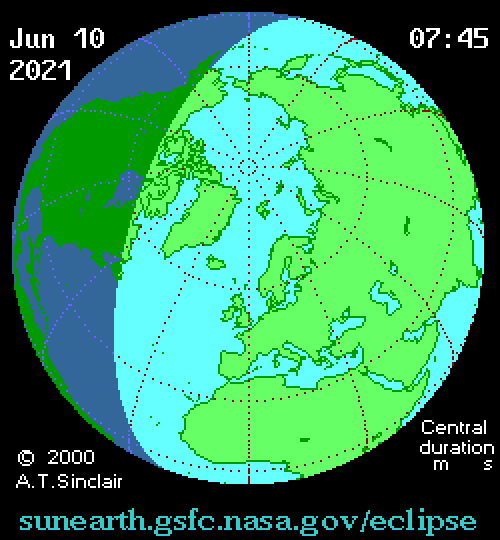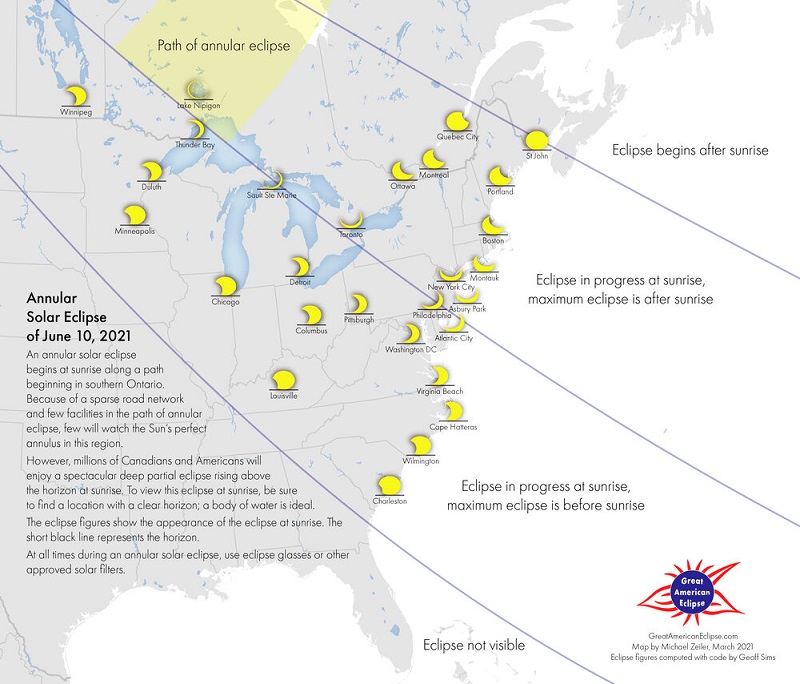
2021’s first solar eclipse
The new moon will sweep in front of the sun to create this year’s first solar eclipse on Thursday, June 10. On that day, the moon in its elliptical orbit around Earth will lie too far from us to cover over the sun completely. So a bright annulus – or ring – will surround the new moon silhouette at mid-eclipse. It’s the outer rim of the sun, not quite hidden from view. People have taken to calling these “ring of fire” eclipses. Essentially, they are partial eclipses, albeit very dramatic ones. As with any partial eclipse, you need eye protection to watch an annular eclipse. Watching with the unaided eye will cause eye damage.
From much of North America, people will see the sun in eclipse at sunrise on June 10. Northerly and easterly locations in the U.S. have the best view. Or you can watch the eclipse live online, at Virtual Telescope TV. The live feed is scheduled for June 10, starting at 09:30 UTC (translate UTC to your time.) More below.
Read more: 7 top tips for observing the sun safely

Path of the annular eclipse
The path of the annular or “ring of fire” eclipse is shown as the curved red swath on the map below. Astronomers call this the path of annularity. You must be within this narrow track along Earth’s surface to see the “ring of fire.”
All in all, this eclipse lasts for about 1 2/3 hours (100 minutes). It starts at sunrise in Ontario, Canada (on the north side of Lake Superior). Then the eclipse path circles across the northern reaches of the globe. Midway along the path, the greatest eclipse occurs at local noon in northern Greenland. Afterwards, the annular eclipse path swings by the Earth’s North Pole. It ends at sunset over northeastern Siberia.
From any one point along this annular solar eclipse path, the middle or annular “ring of fire” stage of the eclipse lasts a maximum of 3 minutes 51 seconds.


Eclipse at sunrise in North America
The eclipse times in this section and the one below are via timeanddate.com. Thanks, y’all!
Within much of North America, people will see the sun in eclipse at sunrise on June 10. In the United States, northerly and easterly locations will enjoy an advantage: a deeper eclipse will remain in view for a longer period after sunrise. For instance, from New York City, the eclipse magnitude will reach a whopping 0.80 (80%). And, from there, the eclipse will last for 1 hour and 6 minutes after sunup.
From the U.S. Midwest and East Coast, it’s to your advantage to find an unobstructed view in the direction of sunrise. Otherwise, you might miss the eclipse entirely.
An unobstructed horizon is especially necessary at the outskirts of the eclipse viewing area:
From Savannah, Georgia, the eclipse magnitude at sunrise is only 0.028 (2.8%). The eclipse shrinks thereafter, lasting only 3 minutes and 24 seconds after sunrise.
From Sioux Falls, South Dakota, the eclipse magnitude at sunrise is only 0.022 (2.2%). It ends one minute and 37 seconds after sunrise.
Find eclipse times for hundreds of cities via EclipseWise.com

June 10 eclipse in Europe and Asia
Europeans can watch the partial eclipse from start to finish, as it will take place higher in the sky. That is, it’ll happen more toward the middle of the day on June 10. Even from Europe, though, it’ll be a fairly shallow partial eclipse. For example, from Oslo, Norway, the eclipse will last for 2 hours and 26 minutes, with maximum eclipse magnitude only a bit over 0.40.
From Asia – where the partial eclipse is visible – the eclipse will happen in the late afternoon on June 10. And, from Beijing, China, the moon will first eclipse the sun some 12 minutes before sunset. The maximum eclipse magnitude of 0.08 (8%) will occur right at sunset on June 10.

Who will see the partial eclipse?
Outside the path of annularity, a partial eclipse will be seen by people on a much larger swath of Earth’s surface. That includes northern and eastern Canada, plus far-northern Alaska. In the United States, the partial eclipse will be visible from the northern Midwest, and along the East Coast (except Florida).
The partial eclipse falls upon the North Atlantic Ocean and most of Europe. It falls on the western and northern parts of Asia.
The closer you are to the path of annularity, the deeper the partial eclipse. Look at the worldwide map above. Going southward of the annular eclipse path, notice the numbers: 0.80, 0.60, 0.40 and 0.20.
Eclipse magnitude and obscuration
These figures (0.80, 0.60, 0.40 and 0.20) refer to the eclipse magnitude. That’s the fraction of the sun’s diameter covered by the moon. For instance, 0.80 means 80% of the sun’s diameter is covered over by the moon. Farther south, the moon covers 60% of the sun’s diameter, then 40%, and so on. South of 0.2, the moon covers over less than 20% of the sun’s diameter.
For a different perspective, the map below via Michael Zeiler at GreatAmericanEclipse.com shows the eclipse obscuration. That is the percentage of the sun’s disk that’s covered over by the moon at maximum eclipse in Coordinated Universal Time (UTC).

Six lunar months from now
Exactly six lunar months (six new moons) after this annular eclipse, there’ll be another solar eclipse. It’ll fall on December 4, 2021. Unlike in June 2021, the December 2021 new moon will present the closest and therefore the largest supermoon of the year.
Thus the December 4, 2021, eclipse will be a total solar eclipse. But, alas, you’ll have to travel to Antarctica to see it.

Bottom line: On June 10, 2021, the rather distant new moon gives us an annular – ring of fire – solar eclipse. The path of annularity will cross the northern part of the globe (northeastern Canada, Greenland, and far-eastern Siberia). A much-larger part of the world (northeastern and far-northern North America, much of Europe and Asia) can watch a partial solar eclipse. Proper eye protection is a must!











